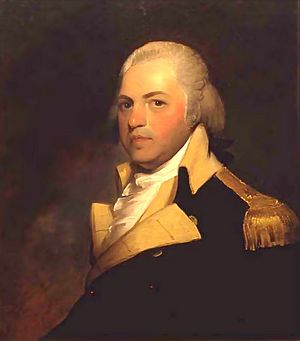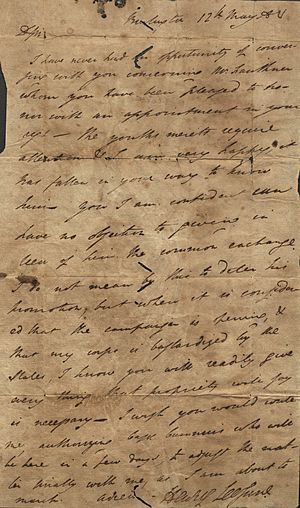Henry Lee III facts for kids
Quick facts for kids
Henry Lee III
|
|
|---|---|

Posthumous portrait by William Edward West (c. 1839)
|
|
| 9th Governor of Virginia | |
| In office December 1, 1791 – December 1, 1794 |
|
| Preceded by | Beverley Randolph |
| Succeeded by | Robert Brooke |
| Member of the U.S. House of Representatives from Virginia's 19th district |
|
| In office March 4, 1799 – March 3, 1801 |
|
| Preceded by | Walter Jones |
| Succeeded by | John Taliaferro |
| Delegate to the Confederation Congress | |
| In office 1786–1788 |
|
| Preceded by | James Monroe |
| Personal details | |
| Born | January 29, 1756 Leesylvania near Dumfries, Prince William County, Virginia, British America |
| Died | March 25, 1818 (aged 62) Cumberland Island, Georgia, U.S. |
| Resting place | University Chapel Washington and Lee University Lexington, Virginia, U.S. |
| Political party | Federalist |
| Spouses |
|
| Children | 9, including Henry IV, Sydney, and Robert |
| Parent | Henry Lee II (father) |
| Relatives | See Lee family |
| Alma mater | Princeton University |
| Signature | |
| Nickname | "Light-Horse Harry" |
| Military service | |
| Allegiance | United States |
| Branch/service |
|
| Years of service |
|
| Rank |
|
| Battles/wars | |
Henry Lee III (born January 29, 1756 – died March 25, 1818) was an important American leader. He was a brave soldier during the American Revolution and later became a politician. He served as the ninth Governor of Virginia and was also a Representative in the U.S. Congress.
During the Revolutionary War, he was a skilled cavalry officer in the Continental Army. His amazing horsemanship earned him the famous nickname, "Light-Horse Harry." He was also the father of Robert E. Lee, who became a famous general in the American Civil War.
Contents
Early Life and Education
Henry Lee III was born on January 29, 1756, at Leesylvania Plantation in Prince William County, which was then part of the Colony of Virginia. His parents were Henry Lee II and Lucy Grymes.
He went to the College of New Jersey, which is known today as Princeton University. He graduated in 1773 and planned to become a lawyer.
Fighting for Freedom: The American Revolution
When the American Revolutionary War began, Henry Lee III joined the fight. He became a captain in a special Virginia cavalry unit. This unit was part of the 1st Continental Light Dragoons.
In 1778, Lee was promoted to major. He was given command of a special group of soldiers called Lee's Legion. This group included both cavalry (soldiers on horseback) and infantry (soldiers on foot). Lee became very well-known for being a strong leader of these fast-moving troops.
Light cavalry units like Lee's Legion were very important. They helped by:
- Scouting ahead to see where the enemy was.
- Fighting the enemy during troop movements.
- Stopping enemy supplies.
- Carrying out quick raids and small battles.
- Leading missions behind enemy lines.
In August 1779, Lee led his troops on a daring raid against a British fort in New Jersey. This was called the Battle of Paulus Hook. The Americans captured many British soldiers and suffered very few losses themselves. For this brave action, the Continental Congress gave Lee a special gold medal. This was a rare honor for an officer who was not a general.
Lee was later promoted to lieutenant colonel. His Legion was sent to fight in the southern parts of the war. He worked with other famous generals like Francis Marion and Andrew Pickens. Together, they captured many British outposts in South Carolina and Georgia. Lee and his Legion also fought in important battles like the Battle of Guilford Court House and the Battle of Eutaw Springs. He was present when British General Cornwallis surrendered at Yorktown, which was a major turning point in the war.
After the War: Politics and Military Service
After the Revolutionary War, Henry Lee III continued to serve his country.
- From 1786 to 1788, he was a delegate to the Congress of the Confederation.
- In 1788, he helped Virginia decide to approve the U.S. Constitution.
- From 1789 to 1791, he served in the Virginia General Assembly.
- From 1791 to 1794, he was the Governor of Virginia. A new county in Virginia was named Lee County in his honor during this time.
In 1794, President George Washington asked Lee to help stop the Whiskey Rebellion. This was a protest by farmers in western Pennsylvania. Lee led a large group of militiamen, and the protest ended peacefully without a major fight.
In 1798, Lee was appointed a major general in the U.S. Army. This was because a war with France seemed possible.
At George Washington's funeral in 1799, Henry Lee III gave a famous speech. He described Washington as "first in war, first in peace, and first in the hearts of his countrymen."
From 1799 to 1801, he served in the United States House of Representatives as a member of the Federalist Party. After leaving public service in 1801, he faced financial difficulties. In 1809, he spent about a year in debtors' prison because he couldn't pay his debts. His son, Robert E. Lee, was only two years old at the time. After his release, Lee moved his family to Alexandria, Virginia.
Later Years and Passing
Henry Lee III wanted to serve in the War of 1812, but President James Madison did not give him a military role. In 1812, he published a book called Memoirs of the War in the Southern Department of the United States. In this book, he wrote about his experiences during the Revolutionary War.
In 1812, Henry Lee III was badly injured during a difficult event in Baltimore, Maryland. He was trying to help a friend, Alexander Contee Hanson, who was being attacked by a group of people. Lee suffered serious injuries to his head and face, and his speech was affected.
To recover from his injuries, he traveled to the West Indies. On his way back to Virginia, he passed away on March 25, 1818. He was at Dungeness, on Cumberland Island, Georgia, and was cared for by the daughter of his old friend, General Nathanael Greene. "Light-Horse Harry" was buried with military honors. In 1913, his remains were moved to the Lee family crypt at University Chapel in Lexington, Virginia.
Family Life
Henry Lee III was married twice. His first wife was his cousin, Matilda Ludwell Lee (1764–1790). They were married in 1782 and had three children:
- Philip Ludwell Lee (1784–1794)
- Lucy Grymes Lee (1786–1860)
- Henry Lee IV (1787–1837), who became a historian and writer.
After Matilda passed away, Henry Lee III married Anne Hill Carter (1773–1829) on June 18, 1793. Anne came from a wealthy and well-known family. They had six children:
- Algernon Sidney Lee (1795–1796)
- Charles Carter Lee (1798–1871)
- Anne Kinloch Lee (1800–1864)
- Sydney Smith Lee (1802–1869)
- Robert Edward Lee (1807–1870), who became a famous general during the American Civil War.
- Mildred Lee (1811–1856)
Works
- Lee, Henry, and Robert E. Lee. Memoirs of the War in the Southern Department of the United States. Eyewitness accounts of the American Revolution. Philadelphia: Bradford and Inskeep, 1812.
See also
 In Spanish: Henry Lee III para niños
In Spanish: Henry Lee III para niños
- Lighthorse Harry Lee Cabin



